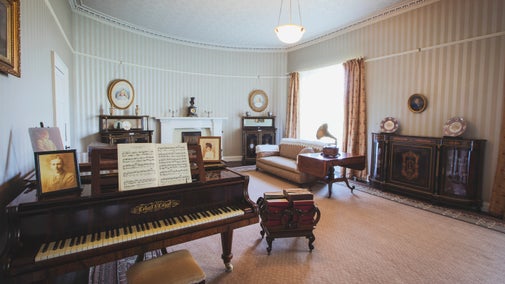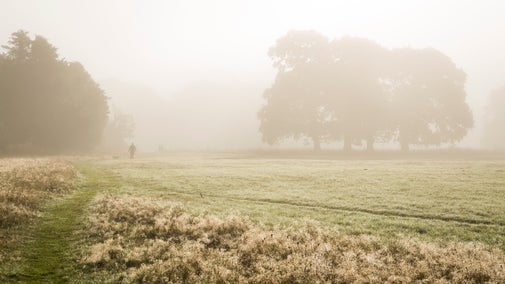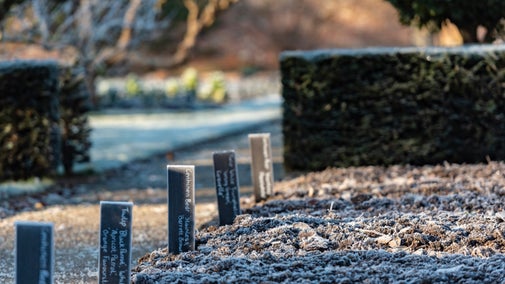
Discover more at Llanerchaeron
Find out when Llanerchaeron is open, how to get here, the things to see and do and more.

For over three centuries the Llanerchaeron estate was home to ten generations of the same family. Each generation contributed to the estate as you see it today with a villa, servants' quarters, stables, farm buildings and walled garden, set in a landscape which is both beautiful and productive. Delve into the history of the people who lived there and learn about how John Nash the architect turned the house into a villa.
Llanerchaeron was purchased in 1634 by Llewellyn Parry, who could claim his lineage all the way back to the Welsh Princes. At this point the estate comprised of a small farmhouse with 500 acres of land and a small formal garden - possibly the first in Wales.
The estate would continue to grow over the following 100 years, with purchases of more land and an advantageous marriage to the Lewis family of the neighbouring estate at Ciliau Aeron.
Colonel William Lewes married a local heiress Corbetta Williama Powell of Nanteos mansion in 1786. Corbetta not only brought greater social status for the Lewis family, but also a large dowry that paid for the renovation works to the farmhouse already situated here.
John Nash was employed as the architect and work started in the 1790s to the house. It was transformed under Nash’s vision from a small farmhouse into the elegant villa that we have today.
When commissioned to design a new house at Llanerchaeron, John Nash was a little known architect from London. He later established his reputation as a great Regency architect responsible for designing the Royal pavilion in Brighton and Buckingham palace.
William and Corbetta's son John Lewis inherited the estate on his father’s death in 1828. John Lewis married Mary Ashby Mettam in 1841. He sadly passed away early into the marriage in 1855 leaving Mary alone at Llanerchaeron without any children.
John made his sister and her daughter heirs of his will and not his nephew, which was a remarkable decision for this period. His will also stipulated that Mary be allowed to stay at Llanerchaeron for as long as she lived, however as she did not own it, she couldn’t make any changes to the estate.
During this period standards of living were changing and new technological advances were being implemented into homes, but under Mary’s management, Llanerchaeron remained unaltered. Reports of Mary’s management are admirable; she looked after the people around her including staff, tenants and neighbours, in a very maternal but progressive way.
- The Llanerchaeron tenants, 1913
Mary continued to manage the estate until her death in 1917 aged 104. She outlived most of the heirs of the original will and the estate eventually passed to Captain Thomas Powell Lewes, Major John Lewis’ Great-Nephew.

Captain T P Lewes, made some minor alterations before moving in to Llanerchaeron in 1919. These were the first substantial changes in over 120 years. The captain incorporated new fireplaces in some rooms, fitted wardrobes in the bedrooms, and the first bathroom installed at Llanerchaeron.
Captain Lewes utilised the water wheel on the estate by adding an electrical system within the house. The water wheel charged up two large batteries that were brought to the house to run electric lights and sockets. Luckily the fabric of the Nash building remained untouched and unaltered.
It was during this period that many historical houses suffered economic hardship. Llanerchaeron managed to survive as the Lewes’ sold some of the acres of farms and land to maintain the estate. On the death of Captain T P Lewes in 1940 his only son, Mr John Powell Ponsonby Lewes, inherited Llanerchaeron.
Mr Ponsonby Lewes lived here successfully managing the estate until his death in 1989, at the age of 89. Mr Ponsonby Lewes left the National Trust the remaining estate of 760 acres along with the villa and farm.

Find out when Llanerchaeron is open, how to get here, the things to see and do and more.
At Llanerchaeron explore Pamela Ward’s eclectic collection of antiques and Geler Jones’s treasure trove of early 20th-century agricultural and domestic machinery.

Llanerchaeron’s Georgian villa created by architect John Nash makes the most of the views across the picturesque Aeron valley. Discover a complete service courtyard at the back of the house.

You can enjoy a walk and see a variety of wildlife year-round at Llanerchaeron in the parkland, woods, meadows and of course the working farmyard.

The Walled Garden at Llanerchaeron in Ceredigion has been growing delicious food for over 200 years. When you visit you can buy fresh produce to take home with you.
